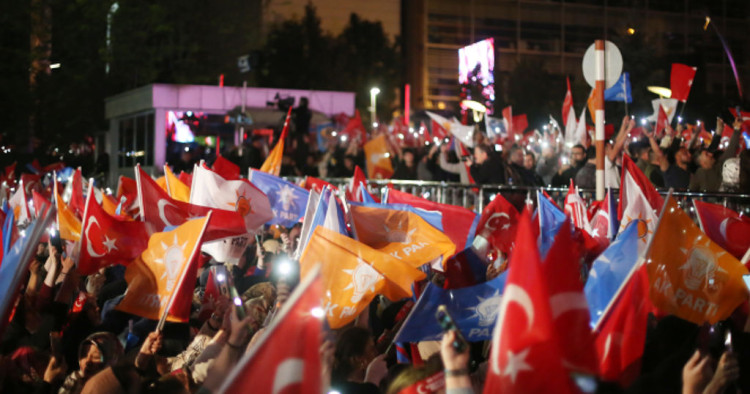Contents:
- Turkey heads for a run-off election with Erdoğan in the lead
- Pakistan’s civil-military faceoff continues to escalate
- Israel and Gaza — another short interval of violence
- Assad invited back into the Arab fold, but Syria remains a regional source of instability and international pariah
- Black Sea grain export deal likely to survive for now, but MENA food insecurity will prevail as long as Russo-Ukrainian war goes on
Turkey heads for a run-off election with Erdoğan in the lead
Howard Eissenstat
Non-Resident Scholar

-
The election results were a mitigated victory for President Recep Tayyip Erdoğan and a disaster for the main opposition, with opposition candidate Kemal Kılıçdaroğlu trailing Erdoğan by nearly five percentage points.
-
Erdoğan is the favorite to win in the run-off election. His coalition has retained control of parliament and nationalist sentiment is surging, putting Kılıçdaroğlu, whose success is reliant on the Kurdish vote, in a difficult position.
Turkish voters went to the polls in huge numbers this Sunday, with over 90% of eligible voters casting their ballots. The results were a mitigated victory for President Recep Tayyip Erdoğan and a disaster for the main opposition, which had entered the elections with high hopes of retaking power after more than 20 years.
An Organization for Security and Cooperation in Europe (OSCE) report notes that the elections were “well managed” but underscores the uneven playing field on which they were contested:
The incumbent president and the ruling parties enjoyed an unjustified advantage, including through biased media coverage. The continued restrictions on fundamental freedoms of assembly, association and expression hindered the participation of some opposition politicians and parties, civil society and independent media in the election process. […] The campaign itself was competitive and largely free for most contestants but characterized by intense polarization, and marred by harsh rhetoric, instances of misuse of administrative resources, and the pressure and intimidation faced by one opposition party. The election administration technically managed elections efficiently, but there was a lack of transparency and communication, as well as concerns over its independence. Measures designed to facilitate registration and voting for earthquake-affected citizens were limited, placing an additional burden on the voters to exercise their voting rights.
In the early hours of the vote counting, it appeared that more direct voter suppression was possible. As in the past, state news agencies provided very high returns for Erdoğan early on; meanwhile, the ruling party filed hundreds of complaints about possible improprieties in ballot boxes in opposition strongholds, sometimes filing scores of complaints about a single ballot box. The goal of these efforts was, presumably, to create an atmosphere of inevitability around an Erdoğan victory and also, perhaps, to provide the government time to respond if the opposition was winning.
In the end, no further intervention was necessary; the opposition candidate for president, Kemal Kılıçdaroğlu, trailed Erdoğan by nearly 5 percentage points, with Kılıçdaroğlu winning 44.88% of the vote to President Erdoğan’s 49.51%. In addition, a third-party candidate, the anti-immigrant, anti-Kurdish Sinan Oğan, received just over 5% of the vote. The presidency will now be determined by a run-off election between Kılıçdaroğlu and Erdoğan, to be held on May 28.
In the parliamentary elections, Erdoğan’s Justice and Development Party (AKP) saw a drop in votes, though it remains the largest single party in parliament. Its losses were, in part, mitigated by the electoral success of its coalition partner, the Nationalist Action Party (MHP), which did considerably better than expected.
Overall, Erdoğan’s popularity has clearly suffered; this is the first time he has been forced into a run-off. Nonetheless, he has been able to retain control of parliament. Moreover, he is the favorite to win in the run-off election. This is true for two reasons. First, his coalition’s control of parliament makes it easy for him to argue that a Kılıçdaroğlu victory would lead to a political stalemate. Second, and perhaps more importantly, the election results evince a surge in nationalist sentiment. While both Kılıçdaroğlu and Erdoğan can make reasonable claims on this portion of the electorate, Kılıçdaroğlu’s success is reliant on the Kurdish vote. Without them, he cannot win, but with them, many nationalist voters will not support him.
Follow on Twitter: @heissenstat
Pakistan’s civil-military faceoff continues to escalate
Marvin G. Weinbaum
Director, Afghanistan and Pakistan Studies

-
At stake is the very fabric of Pakistan’s political system that almost since the country’s inception has given the military superiority over civilian institutions and enabled it to portray itself as the country’s savior.
-
Former Prime Minister Khan’s call for renewed country-wide demonstrations demanding that the government step down in favor of elections contains many of the ingredients for a civil war.
Pakistan may have passed the point of no return in an intensifying clash between its military and former Prime Minister Imran Khan that could portend a resetting of the country’s military-civilian relations. Direct conflict between the military and Khan, odds-on favorite to sweep to power in any free and fair election, has been brewing ever since the military withdrew its support of his government in April of last year. It has been partly obscured by a tug of war between Khan, in his attempt to regain power in an early election, and an interim government led by Shehbaz Sharif, determined to hold on as long as possible. Khan and his Pakistan Tehreek-e-Insaf (PTI) loyalists have been aided in the struggle by a largely friendly judiciary while the ruling coalition of parties has been shielded by the National Assembly. The military, meanwhile, though aligned with the government’s efforts to stave off Khan’s return to power, have strived to give the impression of neutrality — that is, until this pretense became impossible to maintain.
Khan initially placed most of the blame for his difficulties with the military on the personal animosity of Pakistan Army Chief Gen. Qamar Javed Bajwa. Khan and his PTI colleagues nevertheless carefully avoided antagonizing the army’s top brass and expressed their admiration for the military as a national institution. But November 2022, which brought the retirement of Bajwa and his smooth replacement by Gen. Asim Munir, also saw a failed attempt on Khan’s life and the wraps come off the two sides’ underlying antipathy. Khan directly named high-ranking military officials in Pakistan’s principal intelligence agency, the Inter-Services Intelligence (ISI) Directorate, as being behind the attack on him. The antagonism came to a head early last week with the arrest of Khan, charged with one of the tens of government-brought criminal cases pending against him. Angry and resentful of both military and civilian elites, Khan’s sympathizers took to the streets to demonstrate, and with paramilitary forces unable to contain them, the Army was deployed to Punjab and Khyber-Pakhtunkhwa provinces.
The crisis atmosphere appeared at first to ease by week’s end, when the Supreme Court declared the government’s actions in arresting Khan unconstitutional and ordered his release. But the state responded by immediately launching a crackdown on PTI supporters with Shehbaz ordering further arrests and threatening to try culprits in special anti-terrorist courts. Although Khan on his release denounced the rioting and looting that accompanied the country-wide demonstrations by his followers, he sharpened his attack on the military by naming Gen. Munir as behind his arrest by paramilitary forces. He also claimed that the ISI had hatched new plans to murder him. Khan’s remarks seemed well designed to discredit the Army and drive a wedge between the senior leadership and the large number of Khan sympathizers believed to be across its ranks.
At stake in this showdown is the very fabric of Pakistan’s political system that since almost the country’s inception has given the military superiority over civilian institutions and enabled it to portray itself as the country’s savior. The military has previously suffered serious setbacks to its reputation — i.e., the Bangladesh debacle in 1971, the anti-Musharraf lawyers’ movement in 2007, and the embarrassing U.S. attack killing Osama bin Laden in 2011 — from which it has always managed to spring back. But recent pro-Khan protests have displayed a deep-rooted rage against the Pakistan Army that will as never before test the military’s popularity and long-prized unity of command. In what seems a winner-takes-all struggle, Khan’s call for renewed country-wide demonstrations demanding that the government step down in favor of elections contains many of the ingredients for a civil war.
Research assistant Naad-e-Ali Sulehria contributed to this piece.
Follow on Twitter: @mgweinbaum
Israel and Gaza — another short interval of violence
Eran Etzion
Non-Resident Scholar

-
Last week’s round of deadly hostilities in and around Gaza resulted in the targeted killing of three Palestinian Islamic Jihad commanders, 10 civilian Palestinian casualties, more intense retaliatory rocket attacks on Israeli cities, and the opportunity for Israel to battle-test its latest advanced missile-defense systems.
-
Though Netanyahu declared a clear-cut victory, all that actually happened was a validation of the 17-year-old equation: Israel suffocating Gaza with one hand and feeding Hamas with the other, just enough so the latter can galvanize its control of the Strip and prevent any political or territorial re-unification with the West Bank.
Since 2006, when Hamas staged a violent coup and took over the Gaza Strip, 17 rounds of fighting with Israel have erupted, each one ending in a set of “understandings” between the sides, brokered by the Egyptian General Intelligence Service (Mukhabarat), sometimes with the help of other third parties, notably the United States and Qatar. Last week, yet another such round of deadly hostilities broke out and ended, in a similar fashion. The trigger this time was the death of a Palestinian Islamic Jihad (PIJ) detainee in an Israeli prison, after a hunger strike lasting 87 days. PIJ launched a barrage of rockets in retaliation, and Israel — after a week of clandestine surveillance and planning — chose to carry out simultaneous targeted killings of three high-level PIJ commanders. But the surgical strikes resulted in 10 additional casualties, innocent civilians, including women and children. This in turn brought multiple salvos of missiles and rockets onto Tel Aviv and other Israeli cities. The Iron Dome missile-defense system was able to intercept almost all of them, however, and Israel even used the occasion to battle-test another, more advanced system (David’s Sling), recently purchased by the newest member of the North Atlantic Treaty Organization (NATO), Finland.
Curiously, Hamas chose to sit this round out, sending a message to all external actors, mainly Israel, Egypt, and the U.S., that it is a “responsible adult.” Nonetheless, there is much debate as to the real levels of cooperation between Hamas and PIJ, as well as with respect to the Iran-led coordination mechanism encompassing these two organizations, Hezbollah, and other Iranian proxies in Syria and beyond. Iran has been patiently weaving a web of willing and able terrorist organizations around Israel — the so-called Axis of Resistance — with a strategic view to creating substantial deterrence and limiting Israel’s room to maneuver. Indeed, throughout the violent exchange, Israeli decision-makers were constantly trying to avoid triggering this network’s activation. This time, it remained dormant, but its existence will continue to weigh heavily on Israel’s strategic decision making.
After five days and yet another set of “understandings,” presumably identical to the previous ones, calm was restored. True to form, Prime Minister Benjamin Netanyahu claimed a clear-cut victory and went on to declare “we have changed the equation in Gaza.” In fact, all that happened was a validation of the 17-year-old equation: Israel suffocating Gaza with one hand and feeding Hamas with the other, just enough so the latter can galvanize its control of the Strip and prevent any political or territorial re-unification with the West Bank. From Hamas’ side, a political, military, and economic “proof of concept” in Gaza is a prelude to taking over the West Bank. So what role does this leave the PIJ? No more than an instrument for both these actors, as well as for Iran. Until the next round.
Follow on Twitter: @eranetzion
Assad invited back into the Arab fold, but Syria remains a regional source of instability and international pariah
Charles Lister
Senior Fellow, Director of Syria and Countering Terrorism & Extremism programs

-
The normalization initiatives toward Assad’s Syria, driven primarily by Saudi Arabia, Jordan, and the UAE, are ostensibly conditional on getting the refugee issue, cross-border smuggling, and extremist violence under control; but Damascus shows few signs of meeting those conditions.
-
For now, regional diplomatic normalization is unlikely to translate into much more than optics because of the continuation of strict Western sanctions and bipartisan agreement in the U.S. Congress on maintaining a strong Syria policy.
For the first time in 12 years, Syria’s President Bashar al-Assad will attend an Arab League gathering, when the organization’s 22 member states meet on May 19, in the Saudi city of Jeddah. Assad’s planned presence comes at the invitation of Saudi Arabia and follows an intensive recent wave of regional engagements with Assad’s regime, aimed at re-integrating it within the region. Those normalization initiatives, driven primarily by Saudi Arabia, Jordan, and the United Arab Emirates, have been described as conditional — primarily on achieving substantial refugee returns to Syria, curbing regime-linked drug smuggling across the Middle East, countering terrorism and extremism, and securing the release of political prisoners.
Yet despite a flurry of public statements, high-level media interviews, and official multilateral communiques, there is yet to be any evidence of practical conditions, let alone mechanisms in place to enforce any failure to meet them. Thus far, the only actions taken have been concessions to Assad’s regime; and in truth, the likelihood of the regime being willing to do what is necessary to resolve any of the above conditions is nigh-on zero. Meanwhile, the most blatant source of instability emanating from regime-held Syria, the export of the drug Captagon, has spiraled in scale amid normalization developments. In the past four weeks alone, approximately $1 billion worth of Syria-made Captagon has been seized in Saudi Arabia, the UAE, Iraq, and Jordan.
Given the dramatic shift in posture toward the region, it is hard to envision regional states reversing course — even despite Damascus’ predictable refusal to grant meaningful concessions. The regime’s May 13 announcement that the al-Rai and Bab al-Salama border crossings from Turkey into northwestern Syria would be opened was presented as a concession, but it is nothing of the sort. Regime forces have had no influence, presence, or control of either facility in over a decade. When Assad’s representative to the United Nations, Bassam Sabbagh, was asked in the wake of the earthquake by international media, on Feb. 14, why the crossings had not been opened earlier for aid access, he burst into laughter and proclaimed, “Why are you asking me, we don’t even control them!” The regime cannot now claim this is a good faith gesture.
Driven by fatigue, realpolitik, and frustration with U.S. inaction, this regional normalization of Assad’s regime is sweeping 12 years of war crimes and crimes against humanity under the rug. International prosecutors have gathered more evidence to convict Assad of such crimes than the world brought to Nuremberg to convict the Nazi Party — shelving such an enormity of criminal behavior is no minor thing. Global attempts to re-assert long-established norms now looks like an empty effort.
For now, however, it is unlikely that diplomatic normalization will translate into much more than optics. A formidable array of Western sanctions retain a considerable deterrent effect on financial engagements with Syria’s regime and there is no sign that those sanctions will be removed anytime soon. Moreover, the U.S. Congress has introduced legislation known as the Anti-Assad Normalization Act, which would prohibit any future U.S. normalization of the regime, strengthen the existing Caesar Act, launch a government investigation into Asma al-Assad’s Syria Trust for Development along with other cases of regime theft and manipulation of international aid, as well as mandate the sanctioning of foreign airports welcoming the already sanctioned Syrian Cham Wings airline and allegedly repairing their aircraft. Whatever direction U.S. domestic politics travels in the coming years, the Congress’ wide bipartisan consensus on maintaining a strong Syria policy looks all but guaranteed.
Follow on Twitter: @Charles_Lister
Black Sea grain export deal likely to survive for now, but MENA food insecurity will prevail as long as Russo-Ukrainian war goes on
Iulia-Sabina Joja
Director, Black Sea Program

-
Russia has repeatedly violated or threatened to derail the nearly one-year-old Ukrainian grain export deal; but with Erdoğan facing a presidential election run-off on May 28, the Kremlin will probably maintain the deal, at least through May, to give his counterpart in Ankara political support.
-
Though the Black Sea grain deal is likely to remain in place in the coming weeks, food security concerns and economic instability are expected to endure in the MENA region and beyond for the duration of the war.
Russia is threatening to let the Black Sea grain deal expire on May 18, putting food security in the Middle East, North Africa, and elsewhere across the developing world once again at risk. The nearly year-long deal, which was already extended twice, has enabled Ukraine to export agricultural products at reduced capacity through some of its Black Sea ports in exchange for mostly unrestricted Russian exports of grain and fertilizer. Though the deal facilitated by Turkey and the United Nations is supposed to hold for six months at a time, Russia has periodically violated or threatened to derail it as a form of political pressure, including by trying to slow down and obstruct Ukrainian grain exports through the Turkish Straits, ever since the agreement was first signed in July 2022. Based on these patterns, Russia is unlikely to actually terminate the Black Sea grain deal this week. Both Turkey’s government and Russian reports have suggested as much. Rather, given the Turkish election results, with President Recep Tayyip Erdoğan in the lead but moving to a run-off on May 28, President Vladimir Putin will likely maintain the deal in place, at least through May. This way, Ankara remains the mediator of the grain deal and facilitator of food security to the Middle East. In the long run, however, both Ukraine as exporter and the Middle East and North Africa as importers are at risk.
For Ukraine, Russia’s military aggression and economic coercion puts its national economy and long-term export capacity under threat. This, in turn, could heavily impact food security and overall economic stability in the MENA region for the foreseeable future. Compared to pre-war production, Ukraine’s harvest of grain and oil crops decreased in 2022 by 40%. This year, Ukraine’s agricultural production will be significantly lower still, given that vast territories have been mined by Russian forces. Last year, Russia’s war drove up food and energy prices, contributing to double-digit food inflation and food insecurity throughout MENA, especially among countries dependent on both fuel and food imports. A recent World Bank report estimates up to 285,000 newborns in MENA may be at risk of permanently stunted growth due to food price inflation since the start of Russia’s full-scale invasion of Ukraine, and about 8 million children are expected to face food insecurity this year across MENA. Countries in the region have been affected to differing degrees — depending on how unstable their respective domestic situation is, how reliant they are on agricultural imports from the Black Sea region, and how vulnerable their populations are to rising food prices. Though the Black Sea grain deal is likely to stay in place in the coming weeks, food security concerns and economic instability are expected to endure in the MENA region and beyond for the duration of the war.
Follow on Twitter: @IuliJo
Photo by Yavuz Ozden / dia images via Getty Images
The Middle East Institute (MEI) is an independent, non-partisan, non-for-profit, educational organization. It does not engage in advocacy and its scholars’ opinions are their own. MEI welcomes financial donations, but retains sole editorial control over its work and its publications reflect only the authors’ views. For a listing of MEI donors, please click here.













